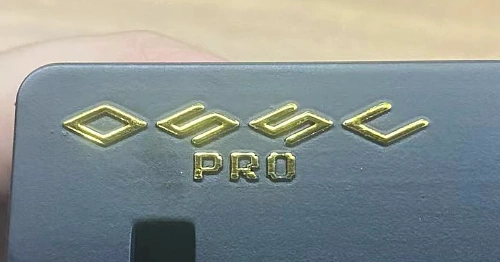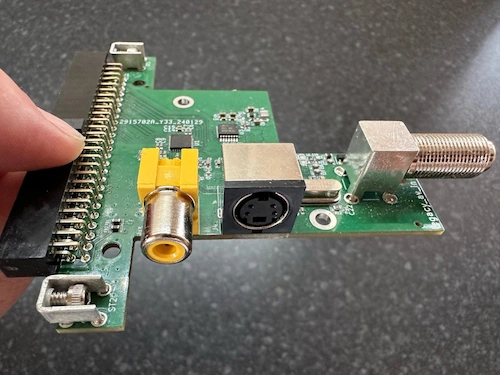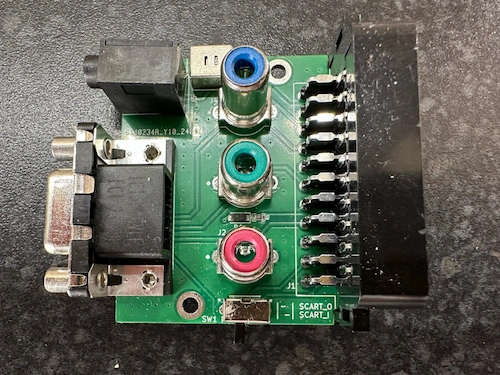| |
|
|
OSSC Newsletter Issue 24 – More OSSC Pro, expansion cards & new firmware!
|
|
Hi,
Welcome to the latest OSSC newsletter. This time around we have an update on the next batch of OSSC Pro (so you can all stop e-mailing in to me!) and also updates on the newest firmwares for both OSSC Pro and OSSC Classic. So what are you waiting for?, time to start scanning this newsletter!
|
Next batch of OSSC Pro due early August
The next batch of OSSC Pro has been ordered at the factory and is expected to arrive in early August 2024. Orders for more units were placed well before our last batch was exhausted, but production was delayed unexpectedly due to a long lead time on the OLED displays the OSSC Pro uses. It seems that we can’t quite escape the spectre of the global component shortage just yet!
Our next batch of OSSC Pro will be even bigger than the previous batch, so there should be plenty of units for everyone and no need for pre-orders or waiting lists. Furthermore, units are expected to arrive at VGP first and then at our friends over at Stone Age Gamer shortly afterwards.
The hardware in this batch will remain basically the same, save for two very minor additions.
1) A small modification to the main PCB to deal with a very tiny number of edge cases where the OSSC Pro could not sync. This mainly affected some Sharp X68000 users and users of the NAC Splitfire JAMMA video splitter. Most other sync issues have been resolved with firmware updates.
2) A gold finish has been added to the logo on the OSSC Pro’s case. While this doesn’t make any difference to the device at the functional level, you have to admit, it does look cool.

We will announce on all our social media channels when this next batch is ready, so be sure to follow us on your favourite platform to get the announcement.
|
| |
Legacy AV in cards on the way
The first batch of legacy AV input expansion cards for OSSC Pro are in manufacturing now and expected to arrive within the next month. We covered these cards in the last newsletter, but for those who need a refresher, this add-on card will allow you to connect both composite video and S-video directly to your OSSC Pro, allowing for many more older systems to be connected to the device without expensive and often invasive RGB mods. This has been the most requested hardware feature since OSSC Pro launched so this expansion card should prove extremely useful to many OSSC pro owners.
The first batch of cards will arrive without support for RF, this is still in development and cards with RF capability will launch at a later date. Price of the card is expected to be around 30 euros.

Final prototype of the Legacy AV in card – Click here to see a bigger version.
AV Input/Output Adapter also due!
Also currently in manufacturing are the AV Input/Output Adapter break out boards. Again, we covered these in detail in the last newsletter. If you need a reminder, the purpose of this adapter is to take the VGA output from the Extra AV Out card and convert it into SCART, suitable for use with European RGB SCART equipped TVs. Furthermore, the adapter is bi-directional, so it can also be used to convert SCART into D-Sub 15 if desired, though the resulting output only works on the OSSC Pro. YPbPr signals, more common on North American TVs, are also supported. The device does NOT process video signals in any way. Resolution and refresh rate are always unchanged.

Final prototype of the AV adapter board
The adapter is extremely helpful for anyone wanting to downscale to a SCART TV. Previously, this required a digital to analogue converter (DAC) that then usually had to go into another adapter (sync combiner or transcoder) and then finally into your RGB SCART television. Using the AV Input/Output adapter makes this much simpler. The adapter also requires no additional power supply. The price of the adapter is expected to be around 25 euros.
|
|
| |
OSSC Pro firmware 0.76
Firmware 0.76 for the OSSC Pro is almost ready to be released. This firmware includes some minor bug fixes and the following improvements:-
Lumacode support – Lumacode is a means of getting a noise-free digital signal from a retro computer or console. This signal is non-standard and requires special decoding, usually through a Raspberry Pi or similar device. Now, you can use your OSSC directly as a Lumacode decoder for C64, Spectrum, Colecovision and MSX, with more systems due to be added in future. Use of optimal sampling modes are required for Lumacode systems, optimal presets are available for all target systems in this firmware.
720p->240p/480i line drop downscaling – Lag free downscaling for 720p sources allows you to downscale many pixel art game titles with even less lag than before.
100/120Hz modes added for 1080i output, for those handful of CRT displays that support this mode.
The firmware also has the following minor enhancements:-
• Disabled SPDIF output when powered off
• Fixed potential bobbing issue with HV sync
• Fixed lack of 0x00/0xFF RGB values with HDMI input
• Fixed garbage on first even field line with LM Bob
The firmware is currently in beta testing and expected to launch soon. As always, we will announce when it is released on all our social media channels, the OSSC announce channel on Telegram and the OSSC-news channel on the Classic Gaming discord.
|
|
| |
OSSC Classic firmware 1.10
It seems the venerable OSSC Classic is still not done. OSSC Classic firmware 1.10 has just released. New features in this firmware include:-
High samplerate for pass through mode – A new higher horizontal sample rate mode has been added. This is primarily for people using the OSSC Classic as an analogue bridge with the PixelFX Morph 4K scaler. Using the high samplerate modes gives an even cleaner, more stable image on the 4K scaler, making it a fantastic solution for the budget conscious user who wants full 4k scaling without huge expense.
Optimal modes available in pass through – Also added primarily for those using the OSSC with the Morph, optimal sampling modes can now be used with pass through mode too.
Sampling jitter reduction – Spend less time tweaking optimal modes and more time playing with improved sampling jitter reduction, meaning in many cases you may not need to dial in optimal sampling phase at all.
VRR flag – Add the VRR flag to the outgoing HDMI signal. This does not implement actual variable refresh rate in any way, but is believed to help reduce stutter or judder on some displays when used with legacy hardware that outputs non-standard refresh rate.
Lumacode support – Lumacode is a means of getting a digital signal from a retro computer or console. This signal is non-standard and requires special decoding, usually through a Raspberry Pi or similar device. Now, you can use your OSSC directly as a Lumacode decoder for C64, Spectrum, Colecovision and MSX, with more systems due to be added in future. Use of optimal sampling modes are required for Lumacode systems.
MSX Sync fixes – Fixes a regression in firmware 1.09 that caused sync issues with MSX computers.
Firmware resources on the OSSC Classic are getting very limited now and unfortunately as a result of adding these new features, profile export is no longer available. We do not anticipate very many more firmware updates for the OSSC Classic now, small bugfixes and support for more Lumacode platforms are expected, but no new major features. If you make extensive use of profiles we strongly suggest you back them up carefully on firmware 1.09 and save them to a separate SD card for use going forward.
The new firmware can be downloaded from this page.
|
|
| |
That concludes this newsletter! We hope that all our customers are enjoying their OSSC devices and that many of you are excited to try these new updates. To be notified as soon as products go on sale, you can follow us on your preferred social media or chat program, by using any of the links below.
Facebook
Twitter
Mastodon
Tumblr
Telegram OSSC Announce channel
Discord – Classic Gaming
Thanks again to everyone who subscribes and everyone who has enjoyed using OSSC over its incredible life span, we hope OSSC 1.8 and OSSC Pro continue to bring you even more happy retro gaming memories.
|
|
|
Might there be a white casing in the future?
Hi, I already have an OSSC Pro (which is terrific!). Is it necessary to mod it as mentioned above for full compatibility with upcoming firmware?
No, you do not need to mod the OSSC Pro for any firmware.
Just a quick question, not sure where to post it. I have a very early OSSC, with DVI out, and up until now, I was using the firmware files ending in “non-audio”. Is it safe to use the “aud” versions, or 0.90 is indeed the last version for my model? Thanks
You must perform a hardware modification on your unit before you can use the 1.xx branch firmware.